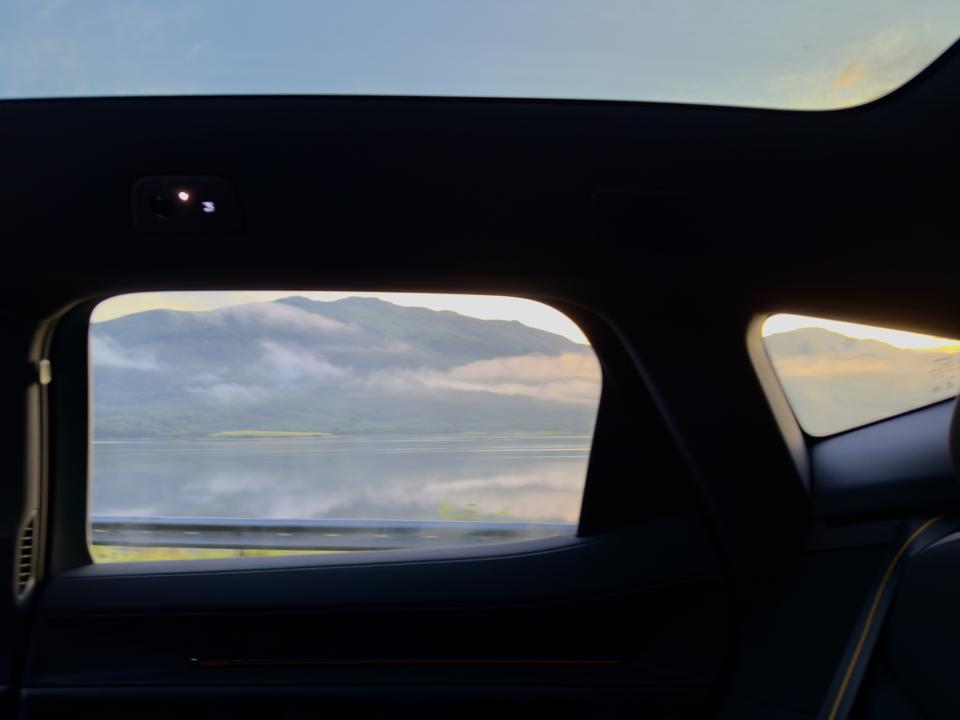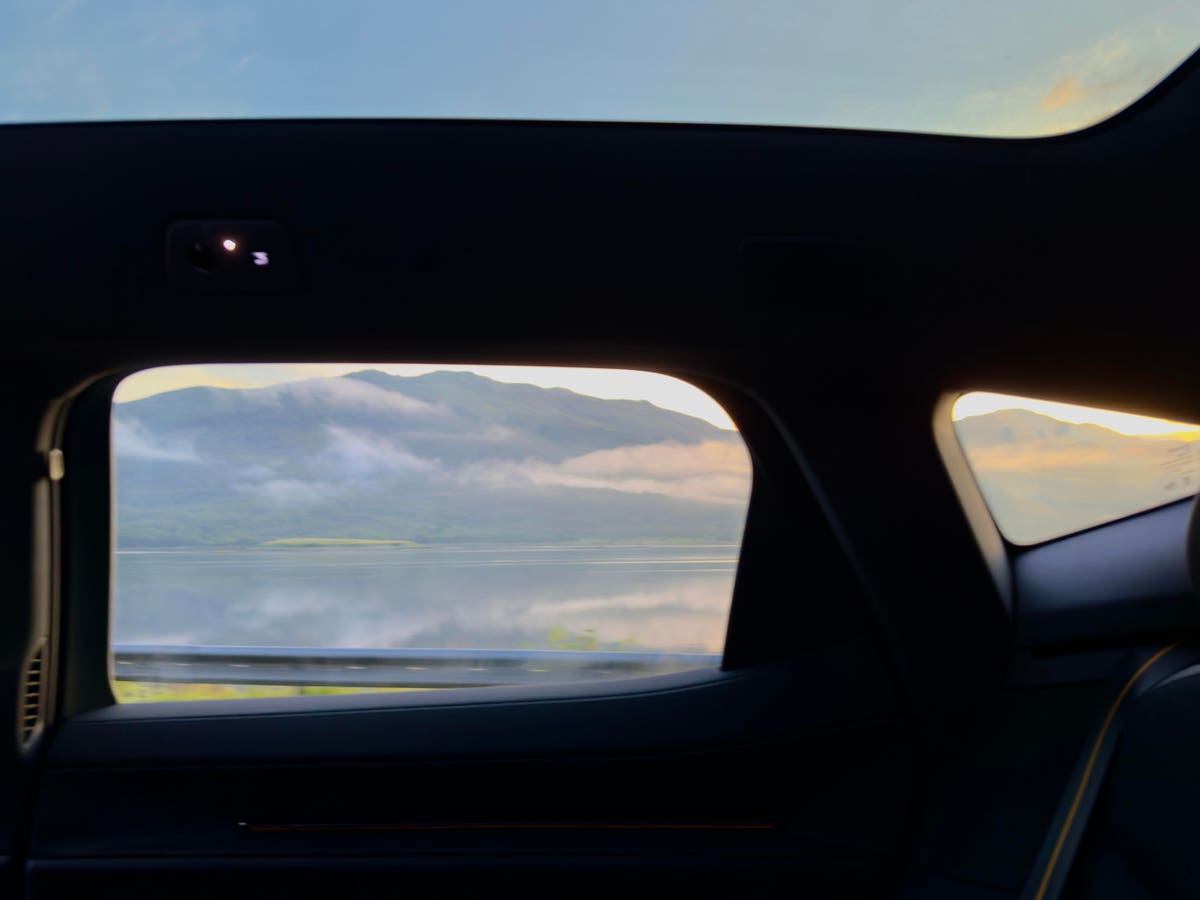
View of Scottish mountains and a loch from the windows of a Polestar electric car.
CARLTON REID
Cell phone reception in the Scottish Highlands is patchy at best, making this rugged backcountry perfect for a digital detox. But we’re in an electric car, and the last thing anybody wants when driving such an advanced bit of kit is tech spottiness. There’s little need to worry on this front: multi-year grant funding from the Scottish government means there are fast EV chargers dotted throughout the Highlands, essentially eliminating range anxiety.
But that’s on the honeypot routes, such as the exceptionally popular North Coast 500, the 21-year-old circular scenic road route beginning and ending at Inverness Castle.
Instead of taking that particular high road, we journeyed with our rental EV along a much less traveled, but historically more resonant, low road. This is thought to be the likely processional route of the medieval kings of Scotland on their final journey from Scone Abbey to burial on the island of Iona, cradle of Celtic Christianity. The 100-mile Road of the Kings runs in part through Glen Lonan with views over to the pyramidical peak of Ben Cruachan and its similarly pointy lower siblings.
Left: Polestar 4 at the Kilchrenan Inn. Bottom right: three couples park their cars close to the Ballygowan farmhouse on the Inverlonan estate in Scotland.
CARLTON REID
Less prosaically, the single-track road through this little traveled glen is designated C32 by officialdom, a bland description not seen on the ground or known to many locals.
We were heading to Inverlonan, home to three upscale bothies with no EV charging points anywhere near. In fact, there is no electricity at all. The luxury bothies are not hooked up to the National Grid, there’s no running water, and visiting the outdoor compost toilet (each bothy has a detached sentry-post hut with a killer view when the door is open, which, in the boondocks, can be almost always) requires the throw of sawdust rather than a flush.
A digital detox on stilts, then.
Inverlonan’s neolithic stone circle and standing pillar.
CARLTON REID
We were in a Polestar 4, a large and luxurious electric coupé. Starting in Newcastle upon Tyne in northern England, we had a journey of 240 miles to reach the Road of the Kings and our bothy. Would we have enough power to survive a long-distance EV journey to this particular off-the-beaten-track highway?
Yes. And it’s partly because of that governmental grant funding of a charging network. Since 2011, the Scottish Government has ploughed over $87 million into Scotland’s public charging network and not just in cities or beside motorways but also in rural and island communities. Scotland met its target for 6,000 public charge points in October 2024, two years ahead of the 2026 target. (In the US, there are now nearly 12,000 fast-charging stations, according to EV-charging data platform Paren. By 2030, there will be three times as many.)
The private sector is now expected to take on responsibility for investing in and operating Scotland’s public charging network. Public charging station provider Gridserve has 68 bays in Scotland. The company recently partnered with home charger network Easee to survey public attitudes to EV charging—this collaboration reveals that 62% of respondents declared themselves more confident in taking an EV on a 300-mile-plus journey than they would have been five years ago. With longer-range cars now more common, range anxiety is becoming a thing of the past.
Charging
Theoretically, with the Polestar 4’s official range of 385 miles, we could do the five-hour trip from Newcastle to near Oban without stopping.
Could, but didn’t. Rather than depleting the battery to naught, we topped up en route, stopping first at a motorway service station where we plugged into an expensive but superfast charger. Charging an EV at home is often free for us, or at worst, cheap as chips. Throughout the day, we can charge for zilch from solar panels on our roof, and after midnight, we benefit from an inexpensive, EV-specific electricity tariff that can fill our EV for peanuts. On the road, costs are higher, with steep prices for ultra-fast charging. Still a lot cheaper than paying for dinosaur juice, mind.
Our bothy overlooked Loch Nell.
Carlton Reid
Breaking our journey for an overnight at the Kilchrenan Inn, a converted 18th-century trading post close to the shores of the aptly-named Loch Awe, we were within easy reach, the following morning, of Oban’s many EV charging stations, where we topped up the battery before heading to Iverlonan via the Road of the Kings. (Topped up to 80% capacity, that is: charging slows between 80% and 100% to protect batteries, so, with plentiful charging stations, there’s little incentive to fill to capacity.)
One of Inverlonan’s bothies perched over Loch Nell.
CARLTON REID
Landscape view
There isn’t a canonical “coffin route” of Scottish kings from Scone to Iona via Oban, but it’s entirely plausible that what would have once been a dirt track through Glen Lonan would have been part of such a medieval journey. This is because the now asphalted road that wends its way through the glen bisects an ancient ritual landscape dotted with meaning. In this ritual landscape, groups of people would have gathered to celebrate special events and to conduct ceremonies. The road was a notable thoroughfare thousands of years before early Christians trod the same route. Close to the road are ancient chambered cairns; Iron Age hillforts known in Scottish Gaelic as duns; the Neolithic Strontoiller stone circle adjacent to the 13ft Clach Na Caraig standing pillar; Neolithic cup-marked rocks; and two tiny artificial islands known as crannogs.
Chef Tim Kensett cooks in a lean-to beside a byre for three couples. The 500-year-old byre is the original Ballygowan farmhouse.
CARLTON REID
The crannogs are on Loch Nell, a tranquil inland loch, and some argue they could have been constructed as solar observation sites. Most scholars consider crannogs to have been built, used, and reused from the Late Bronze Age to the medieval period. Still, the origins of some could lie 3,000 years earlier than previously thought, in the Neolithic, the period when farming, pottery, and burial monuments first arrived in Scotland. Over 400 crannog sites are recorded, with many more no doubt lying undetected. There’s a possible third crannog on Loch Nell, today submerged.
It’s often claimed that 48 Scottish kings and numerous others from Norway, Ireland, and France are buried on Iona; Shakespeare’s Duncan and Macbeth among them. The east-to-west processional from Scone, near Perth, to Oban would have been a journey of about 100 miles and would have involved a great deal of privation.
The lean-to attached to the Ballygowan byre; chef Tim Kensett prepares local food, much of it foraged.
CARLTON REID
Naturally, it’s somewhat easier today, especially in a luxury vehicle. And the luxury continues once we’re on the Inverlonan estate, which operates the Inverlonan bothies.
Bothies are usually stark stone shelters, with little in the way of amenities, located in remote places where hikers, cyclists, and mountaineers need to stay the night. According to the Mountain Bothies Association (MBA), which lists 100 or so bothies throughout the UK, but mainly in Scotland, a bothy was “originally farm accommodation for itinerant workers.” Now, continues the definition, a bothy is an “open shelter usually in a remote location where travellers might have need of four walls and a roof.”
MBA bothies are free to use. Inverlonan’s bothies are purpose-built, architect-designed, made-in-Scotland, and cost $337 per night. They are upscale huts rather than MBA-style bothies.
Tiny’s Cairn overlooks Loch Nell. It was built as a tribute to Lupi Moll’s wife, Tiny, who died 13 years ago from cancer. Lupi owns the Inverlonan estate.
CARLTON REID
Made by social enterprise Bothy Stores, a collaboration between artist Bobby Niven and architect Iain MacLeod, the bothies are said by the makers to be “modestly scaled yet exceptionally detailed prefabricated cabins that offer outstanding versatility.”
Inverlonan’s bothies are sited above Loch Nell, tucked between ancient oaks and with astounding views down to the water and over to the nearby mountains. They’re situated about a mile away from Ballygowan farm, a derelict set of buildings where we’d return for an evening meal.
Loo with a killer view over Loch Nell. Golden Retriever Erica swimming in the loch.
CARLTON REID
There’s no access to the bothies with a car, so we parked up and decanted into an off-road buggy for the bumpy ride to our secluded bolthole. We had chosen the dog-friendly Beatha, (pronounced bay-ah) a snug cabin with a Gaelic name that means “life”—it’s the same word as in Macbeth, which means Son of Life. One of the other two nearby bothies is lochside, called Uisge (oosh-ka), Gaelic for water—uisge beatha, or “water of life,” is the origin of the word “whisky.” The third bothy is called Sitheil (she-eel), which translates as “peaceful.” Apt names all.
The bothies are gloriously off-grid and their placement was the idea of former barrister Lupi Moll, whose family has owned the 1,400-acre Inverlonan estate since Victorian times.
Before arrival, guests are emailed a list of provisions to order, all local: oats from Aberfeldy; bacon and sausages from Gilbert’s free-range farm in Taynuilt; milk from the Wee Isle Dairy on the Isle of Gigha; garden greens from Moll’s garden.
We also chose a pizza kit with sourdough bases perfect for cooking in the outdoor pizza oven, fed with wood we chopped ourselves. On the deck, a Yeti cool box serves as a fridge.
Inside the bothy is a kitchenette, dining and lounging areas, and a mezzanine bedroom. There’s bespoke furniture hewn from local ash trees by Oban-based craftsman Michael Acey. There’s an indoor, wood-fired stove. There’s also a wood-fired sauna in a converted horsebox by the banks of the loch, shared between the three bothies.
Outdoor cooking, Inverlonan.
CARLTON REID
On one of the nights we were there, we also shared an outdoor fine dining experience. We hiked over to the Ballygowan farm buildings, where, in a 500-year-old byre, we three couples were treated to a home-cooked meal with food foraged and grown hyper-locally. There are no food miles concerned; everything was measured in food metres. Kensett—former head chef at Storico, New York; Goldeneye, Jamaica; and The Fife Arms, Braemar—cooked outdoors on embers in a lean-to. His eight-course menu was off-the-scale scrumptious, and made all the more so by eating it inside the single-story, simple crofter’s farmhouse, carpeted with straw, and lit with tea lights and candles in wall nooks.
Sun rise from Loch Nell over to the pyramid peak of Ben Cruachan. Erica stands near a neolithic stone above Loch Nell. Bottom right: one of the two (or three perhaps) crannogs on Loch Nell.
CARLTON REID
We were decidedly off-grid, but boy, this was living! Eco living, and in tune with Moll’s future plans for the estate. The byre—the estate’s original farmhouse and Inverlonan’s oldest building—will be left as is, but the 18th and 19th Century farmhouse next door is in the process of being converted to a sustainable and ecologically sensitive boutique hotel, restaurant, and a bike store. There will be geothermal underfloor heating throughout—the heat for this and the hot water will be obtained from boreholes.
Sadly, there won’t be any electricity generated by the borehole heat so there’s no chance of an EV charging point but then it’s only seven miles to the several fast chargers in Oban.
